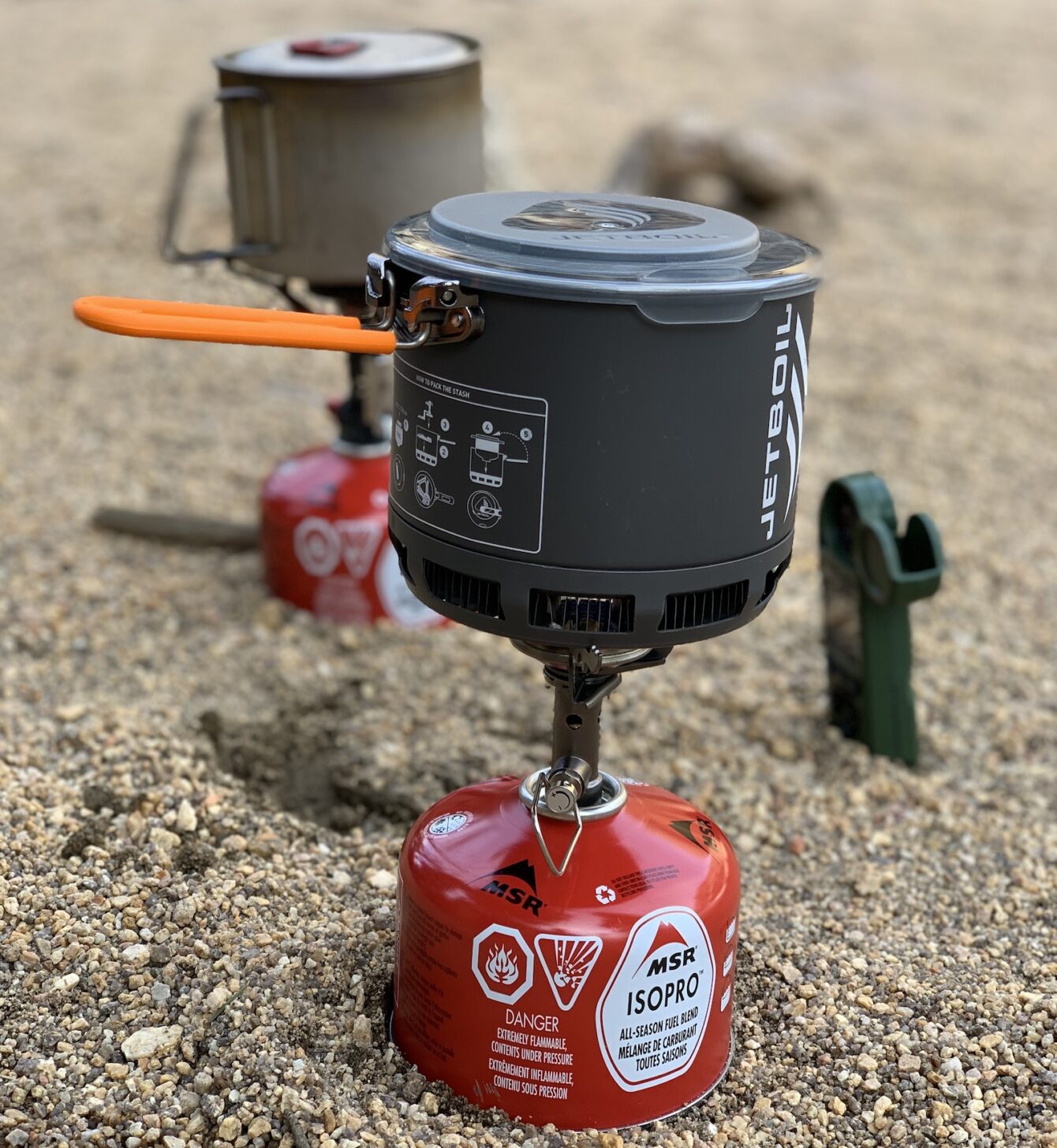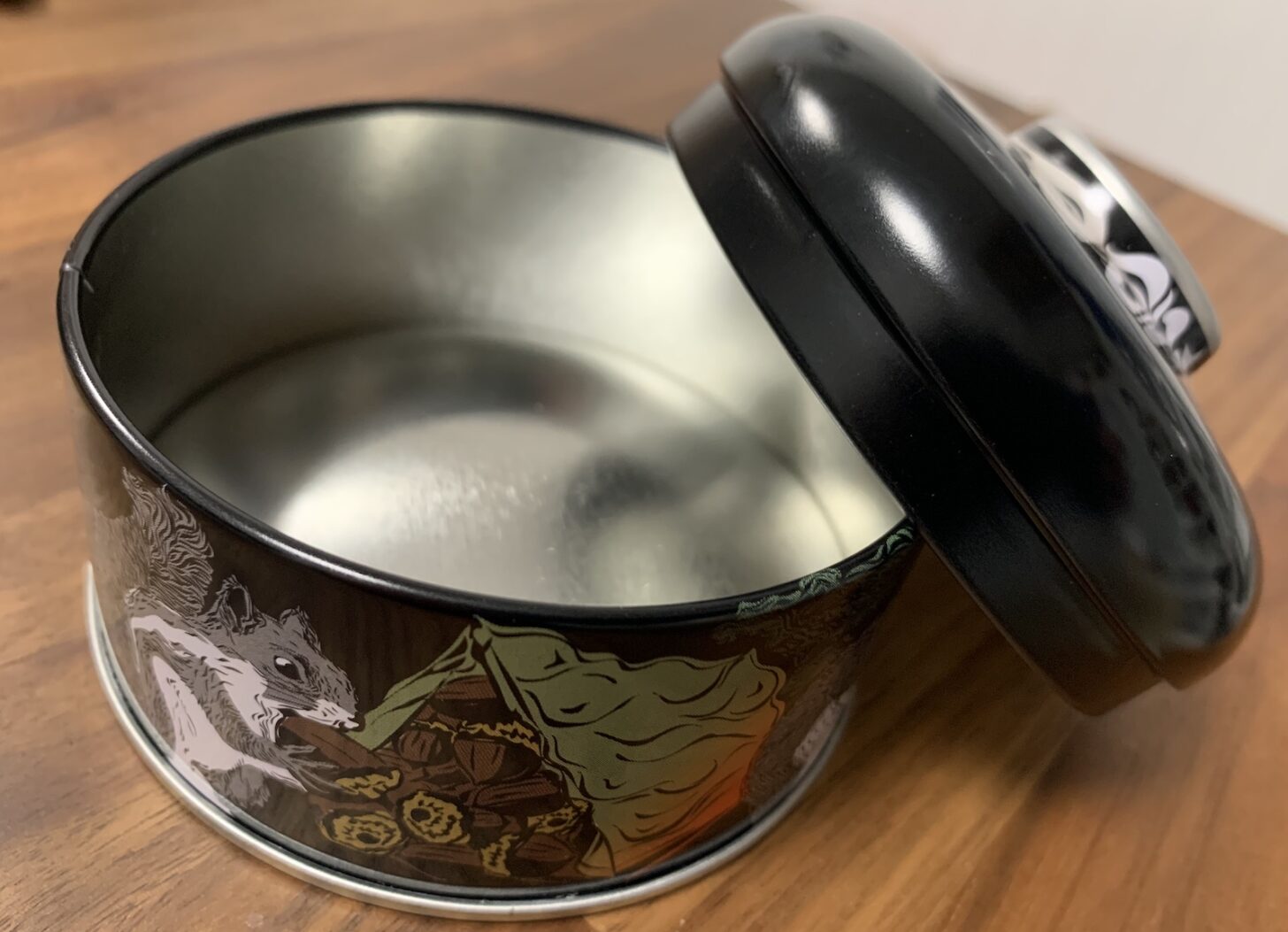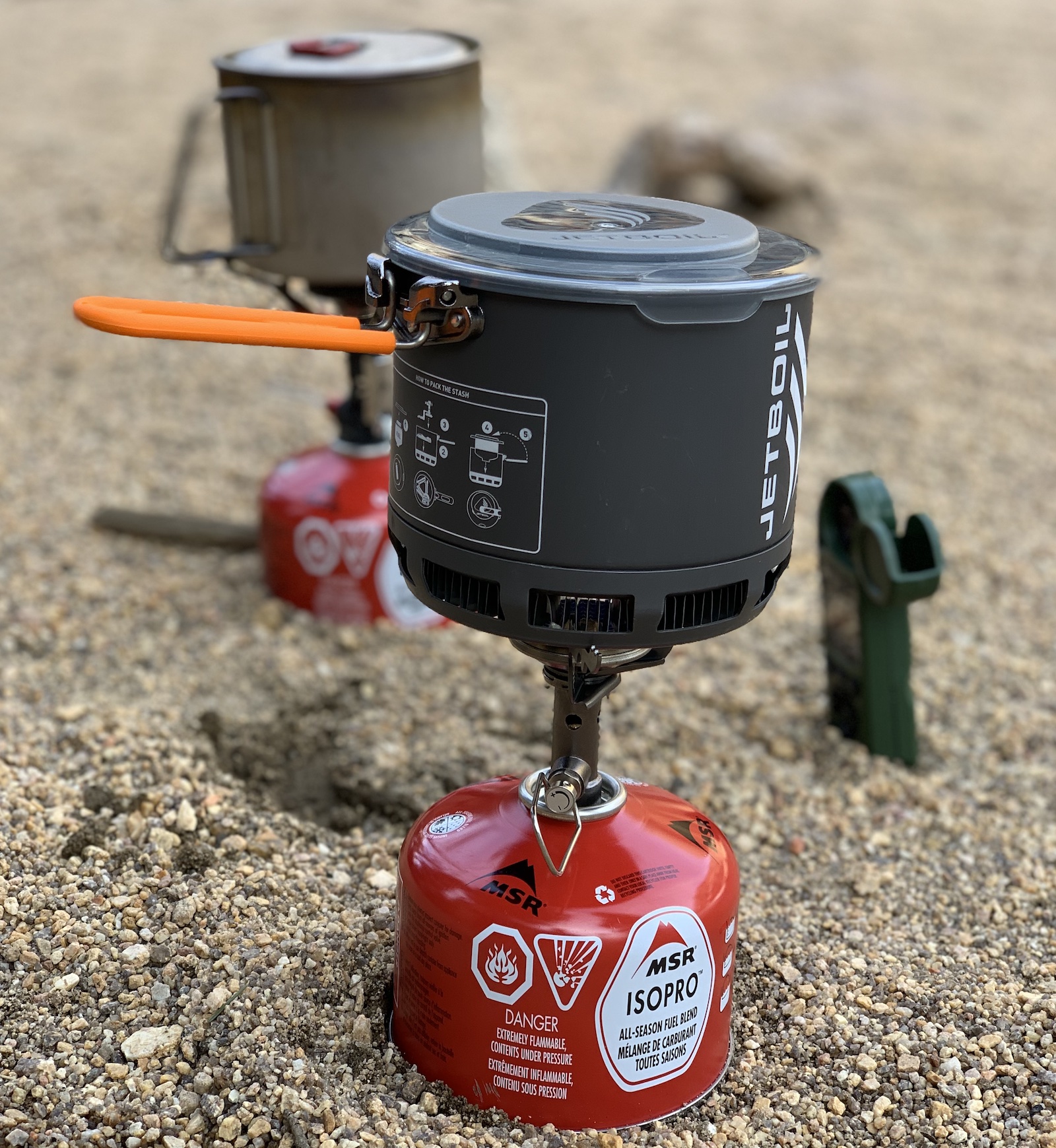Introduction
Product reviewers across the internet are singing high praise for the new Jetboil Stash. Jetboil sent loaner samples prior to its release to YouTubers, bloggers, and affiliate marketers. Some claims that have been written:
- “Despite below-freezing temperatures and high elevation, the Stash boiled water for oatmeal in under two minutes.”
- “Lightest, most efficient stove ever.”
- “At the heart of the Stash system is the burner/regulator. Made of titanium, this component marks the biggest technological advancement in the Stash.”
- “Best backpacking stove … signature Jetboil performance and features…”
- “We field-tested the new JetBoil Stash Stove System for winter hiking and camping in the Appalachian Mountains including below freezing and windy conditions.”
- “Lightest, most efficient backpacking stove ever.”
Another reviewer writes that it “performs on-par with similar canister stoves in wind” but acknowledges that “in anything more than a light breeze a windscreen is needed. However, a simple foil one weighs little, certainly far less than the big collar found on more wind resistant Jetboil stove systems.”
This reviewer’s comments suggest that a “simple foil windscreen” is all that’s needed to address the deficiencies of “similar” canister stoves (which are no longer “par-stoves” when considering the performance of wind-resistant canister stoves from MSR and Soto (which have now been on the market for several years).
In addition, those of us that spend any amount of time camping in windy conditions know that a “simple foil windscreen” not only adds complexity to our cooking systems, but can’t hold up to anything more than a 5 mph breeze unless they are made of metal that’s several mils thick, and adds 2-3 oz (57-85 g) to our cooking system. And we’ve already shown that the big collar on other Jetboil stoves does little to improve the wind-resistance of their burners. Our members have been removing the plastic collars from Jetboil stoves (to remove weight) since they hit the market in the mid-2000s, with no loss of performance.
So I’m curious to see how the Stash actually performed in the field and when subjected to inclement weather. To do that, I had to resist the urge to accept the pre-release invite to test samples of the Jetboil Stash provided on loan for a very limited period. Instead, I bought my own and spent a little time getting to know her. Sort of a pre-engagement period, I suppose, before popping the question:
Dear Stash, would you like to become a part of my gear kit?
This isn’t a product review – it’s a test report. And I only test performance in terms of boil times and fuel economy. I’m not going to talk much about ergonomics, design, aesthetics, its cute nesting features, the included squirrel-branded repurposed mini-gas canister stash container, or brand marketing.

And to be fair, when I unboxed the stove kit, my immediate response to the ergonomics and aesthetics of the kit was “well done”.
What I like:
- That I can snap-fit the bottom of a 110-g net weight fuel canister into the plastic lid inside the pot without it rattling around.
- That the pot can fit a larger, 220-g net weight fuel canister.
- That the stove’s pot supports have indentations that keep the pot centered on and affixed to the stove even if used on a slight incline. In fact – I love this feature.
- The stash container is a really nice touch and a fun keepsake, and of course, it can be used to secretly store myriad substances like Tinder-Quik tabs, etc. The art is great and the theme (a repurposed gas canister) is cool.
- A small (0.8 L) and light (5 oz / 140 g) heat-exchanger pot.
- A titanium burner that resists rusting. My main gripe with steel burners, which accumulate rust that clogs burner ports which degrades performance over the long term.

What makes me pause:
- Same traditional Jetboil burner design, which lacks some power and wind resistance relative to today’s market average.
- Plastic, press-fit lid that’s difficult (and a little bit dangerous) to remove when the pot is boiling and you want to add food. This kit is fine-tuned for water-boiling, not simmering.
Description of Testing
For all tests described in this report, the Jetboil Stash Cooking System was directly compared to the highest-performing upright canister stove we’ve tested, the MSR Pocket Rocket Deluxe (which was used with the 0.9L MSR Titan Kettle). In outdoor tests, both stoves were operated side-by-side so they were exposed to the same wind condition.
The StoveBench stove testing protocol was used for all tests. The following table summarizes the test parameters for each of the tests conducted:
| Control | Mild Outdoor | Moderate Outdoor | |
|---|---|---|---|
| Elevation | 7,190 ft | 8,860 ft | 7,190 ft |
| Ambient temperature | 68 F | 45 F | 28 F |
| Precipitation | n/a | none | light snow |
| Average Wind | n/a | 4 mph | 1 mph |
| Measured Wind Gusts | n/a | 12 mph | 6 mph |
| Starting water temperature | 3 C | 4 C | 1 C |
| Ending water temperature | 91 C | 89 C | 91 C |
| Water volume | 500 ml | 700 ml | 700 ml |
In addition, I conducted tests with the Jetboil Stash burner and the MSR Titan Kettle, and with the MSR Pocket Rocket Deluxe burner and the Jetboil Stash heat exchanger pot. These tests were the most enlightening – they helped me answer the question about whether the Jetboil Stash burner (playing the part of the pig in this theatre) or the heat exchanger pot (playing the role of the lipstick) were the most important components of the system.
Control Test Results
The following table summarizes the test results for the controlled, indoor environment for the Jetboil Stash (“Stash”), the MSR Pocket Rocket Deluxe (“PRD”), and the averages from all of the stoves in our Upright Canister Stove Gear Guide. PRD test data was collected in May 2019 as part of that Gear Guide but repeated again in March 2021 simultaneously with the tests performed on the Jetboil Stash. Both data sets are presented in this table.
| Stash | PRD (May 2019) | PRD (March 2021) | Average of All Stoves (May 2019) | |
|---|---|---|---|---|
| Boil Time (mm:ss) | 4:03 | 3:05 | 3:11 | 3:23 |
| Fuel Consumed (g) | 5.7 | 10.6 | 10.8 | 11.6 |
| StoveBench Score (F) (L-degC/min-g) | 1.95 | 1.45 | 1.29 | 1.16 |
| F_economy (L-degC/g) | 7.89 | 4.33 | 4.10 | 3.87 |
| F_power (L-degC/min) | 11.11 | 14.29 | 13.90 | 13.12 |
As a side note before diving into the data more deeply, note that the StoveBench scores (and general performance) of the PRD decreased slightly from May 2019 to March 2021. I’ve seen the same pattern on all stoves for which I’ve conducted StoveBench tests over a multi-year period. The performance decrease may be due to the accumulation of dirty fuel residues in the jet and burner, the accumulation of rust on steel burner parts that interfere with flame efficiency, and degradation of the Lindal valve seal on the stove. (I haven’t investigated this trend in detail, so these explanations are conjecture at this point.)
When comparing StoveBench scores between upright canister stoves, the Jetboil Stash Cooking System scores higher on fuel economy (F_economy, i.e., that fraction of the StoveBench score that describes how much water was heated for a given amount of fuel) than any of the stoves we tested in our Upright Canister Stove Gear Guide. This is to be expected, given that the Jetboil Stash incorporates a heat exchanger pot and a low-power (4500 BTU) burner.
However, the Jetboil Stash scores lower on power (F_power, i.e., that fraction of the StoveBench score that describes how much water was heated in a given amount of time) than the average upright canister stove we tested. Again, this isn’t surprising given that the Jetboil Stash is a low-BTU burner.
Of course, you should take the results of the StoveBench Control Test with a grain of salt. It’s only meant to be a baseline test to get a feel for burner economy and power in optimum conditions. It’s more important to compare stove performance under more adverse conditions, e.g., higher water volumes, lower ambient temperatures, and exposure to wind – the types of conditions we may experience on a trip where we want (need) our stoves to perform well.
Mild Outdoor Environment Test
The following table compares the test results under mildly stressful environmental conditions:
Member Exclusive
A Premium or Unlimited Membership* is required to view the rest of this article.
* A Basic Membership is required to view Member Q&A events




Home › Forums › Lipstick on a Pig? Wind & Cold Temperature Testing of the Jetboil Stash (StoveBench)